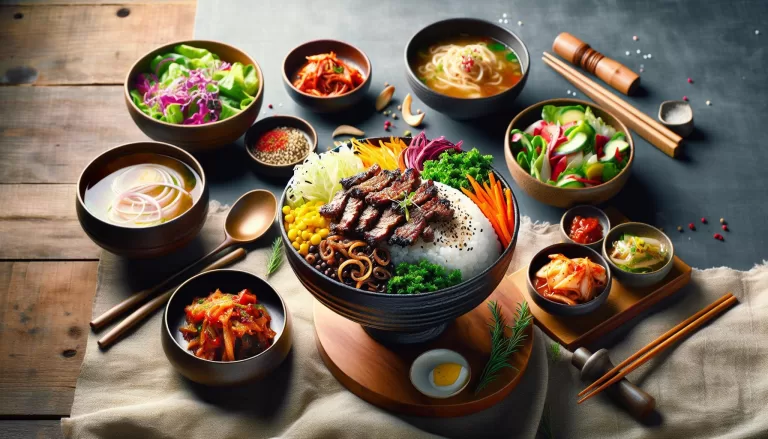Easy and Delicious Homemade Gimbap Korean Seaweed Rolls Recipe Guide

Choosing the Right Ingredients
The quality of your Gimbap largely depends on your choice of ingredients. It’s crucial to select top-notch, fresh components to ensure your homemade Gimbap turns out flavorful and healthy. Let’s delve into the details.
One of your main ingredients will obviously be dried seaweed sheets. These are easily available in Asian supermarkets, and you’d want sheets that are thin yet sturdy, with a deep green color and a clean, oceanic smell.
Next, short-grain rice forms the base for your roll. You might come across various types, it’s important to choose sushi rice to achieve the perfect stickiness for your Gimbap. Remember, great rice is cooked rice that holds its texture without being mushy.
For fillings, you have endless possibilities. The classic version uses yellow radish pickles, carrot, spinach, egg, and beef. These should be fresh and crisp, cleaned properly. You can trade regular beef with marinated beef to give it an extra kick.
| Classic Version | Extra Kick Version | |
|---|---|---|
| Yellow Radish | Yes | Yes |
| Carrot | Yes | Yes |
| Spinach | Yes | Yes |
| Egg | Yes | Yes |
| Beef | Yes | No |
| Marinated Beef | No | Yes |
However, don’t feel limited by these fillings. You can experiment with cheese, seafood, kimchi, or roasted sesame seeds as some alternative ingredients to make your homemade Gimbap unique.
The surprise element in Gimbap can be sauces. The choice of sauces can change the entire taste of your roll. Go with the traditional sesame oil and soy sauce for the classic taste, or venture into the world of gochujang (Korean chili paste) and wasabi for a foreign twist.
There’s no hard and fast rule. Flexibility and creativity are what make the process exciting. The choices you make, the variations you try out, will take you a step closer to elevating your culinary skills.
Preparing the Rice and Fish

For a truly memorable Gimbap, the sushi rice and fish cannot be overlooked.
Let’s start with the rice. You’ll need about 2 cups of uncooked sushi rice. It’s essential to rinse your rice under cold water until it runs clear. This ensures the stickiness, so important for Gimbap. Once rinsed, boil your rice. Your water-to-rice ratio should be about 1.2 to 1.
As the rice cooks, mix together 2 tablespoons of vinegar, 1 tablespoon of sugar, and 1/2 teaspoon of salt. Heat this mixture until the sugar dissolves, then set it aside. Once the rice is cooked, mix it with this sweet vinegar mixture — your sushi rice is ready!
To the fish. Gimbap traditionally employs cooked beef, but why not try with seafood? Start with 150g of raw salmon or tuna. Slice your fish into thin strips of about 1/2 inch thickness.
Here’s a tip that goes a long way: Marinate the fish. Use about 1 tablespoon of soy sauce, 2 teaspoons of sesame oil, and 1 teaspoon of sugar. Allow the fish to marinate for at least 20 minutes before cooking.
For the health-conscious readers out here, the nutrition values might interest you. The sushi rice contains about 240 calories, 52g of carbs, and 4g of protein per cup when cooked. The fish, on the other hand, brings in about 20g protein, 13g fat, and an impressive contribution to your vitamin B12 needs.
| Sushi Rice (per cooked cup) | Fish (raw, 150g) | |
|---|---|---|
| Calories | 240 | Variable based on type |
| Carbs | 52g | 0g |
| Protein | 4g | 20g |
| Fat | 1g | 13g |
Assembling the Gimbap Rolls

Once the sushi rice is prepared and the fish is properly marinated, it’s time get rolling with your Gimbap!
First, lay out a bamboo sushi mat on a flat surface. Over this, spread a thin layer of the sushi rice on a sheet of dried seaweed, leaving the top inch free. It’s that simple, yet crucial, sushi trick: the rice acts as a glue, but you need that free space to seal everything up. But here’s a tip you might have not heard of: wet your hands before handling sushi rice. Keeping your hands damp helps in preventing the rice from sticking to them.
Next, you can start laying out your marinated fish– salmon or tuna, or even both. Remember, placement is key here: lay the fish across the lower third of the seaweed sheet, maintaining a neat line for that perfect sushi cross-section. Try a unique take by adding a slice of avocado or even some cream cheese – this is your masterpiece, after all!
Lastly, roll the Gimbap using the bamboo mat. Apply a little pressure to ensure that the Gimbap stays firm and doesn’t fall apart while you are enjoying it later.
Recipe:
| Ingredient | Quantity |
|---|---|
| Sushi Rice | 2 cups |
| Dried Seaweed Sheets | 10 sheets |
| Marinated Fish | 500 grams |
| Avocado | 1 (optional) |
| Cream Cheese | 50 grams (optional) |
You might be wondering about the nutritional value of your homemade Gimbap. Here’s a quick breakdown:
Nutrition per serving:
| Nutrition | Amount |
|---|---|
| Calories | 350 kcal |
| Carbohydrate | 80g |
| Protein | 22g |
| Fat | 9g |
Rolling and Slicing Techniques

Now that you’ve got your ingredients laid out, you’re ready to roll. Start with the bamboo sushi mat at the ready. Remember, you’ve got to keep those hands wet to prevent the sushi rice from sticking to them.
The Art of Rolling
Take the nori sheet on your bamboo sushi mat. Spread a layer of sushi rice on it, leaving about an inch from the top clear. This will aid in sealing your roll.
Next, arrange your marinated fish in a line across the rice. Don’t be afraid to customize here; salmon and tuna are popular choices, but feel free to mix it up. Add some cream cheese or avocado if you’re feeling adventurous too!
Squeeze – they call it the sushiman’s handshake. Hold the fillings in place with your fingers while you roll the sushi with the mat. Roll the Gimbap firmly but gently, ensuring no filling escapes.
In the end, you should have a beautiful, tight sushi roll.
Perfect Slicing
Now for the grand finale, slicing the roll. A sharp knife is your best friend in this step. Dipping the knife in water between slices helps to make clean cuts without tearing the nori.
Cut the Gimbap rolls in bite-sized pieces, each approximately 1 inch thick. The smaller size makes them easier to enjoy!
As you master these techniques, you’ll find that making Gimbap at home becomes part of your culinary repertoire. The possibilities for flavor combinations are limitless, and the satisfaction of crafting these delicious rolls is immeasurable.
Getting hands-on with this Gimbap recipe isn’t merely a cooking process; it’s a journey, a delightful journey in exploring culinary skills and unearthing diverse flavors. That’s the true beauty of homemade dishes; you’re at the helm, ready to set your own course. So, dive in, experiment and most importantly, savor the experience. Remember, there’s no right or wrong here – it’s totally up to you how you want to take your Gimbap game to the next level.
Serving Suggestions

Once you’ve prepared your homemade Gimbap rolls, you’re not quite done yet. The journey continues with exploring different ways to zest up your meal! In this Serving Suggestions section, we’ll explore the various ways to do that.
Want to add a side? Try serving your Gimbap with a bowl of misoshiru (miso soup). It’s packed with nutrients and complements the gimbap perfectly. You can buy miso paste in most supermarkets, and it’s straightforward to prepare. Just remember to add your desired veggies, tofu, and seaweed.
If you’re into sauces, be experimental. Try dipping your Gimbap into a mixture of soy sauce and wasabi. Alternatively, if you prefer a sweet and spicy kick, go for some gochujang (Korean red chili paste) mixed with a little vinegar. Both sauces enhance the flavor profile of the Gimbap without overpowering your palate.
Let’s talk about the presentation; because we eat with our eyes first, don’t we? Arrange your Gimbap so they line up just right on a cool serving flat plate. And no rule says you can only serve Gimbap in bite-size pieces! You can also cut your Gimbap into larger sections, wrap them in foil, and create Gimbap burritos – A fun and unique way to enjoy this classic dish!
While Gimbap is typically enjoyed fresh, you can also refrigerate it for later enjoyment. Just make sure that when you do want to eat it, let it come to room temperature before serving for the best flavor experience.
Remember, don’t rush – take some time to sit down and savor every bite of your homemade Gimbap. Enjoy the process of discovering and mastering this incredible culinary adventure. And as always, don’t forget to share the wealth! Get your loved ones around and make it a memorable feast. Gimbap serving suggestions are like a blank canvas; hence, it’s best to let your creativity run wild.
Keep an eye on our next section, cutting tips for seriously delicious Gimbap. Remember, practice makes perfect – so roll, slice, serve, and repeat! Go, ignite your taste buds now.
Conclusion
So, you’ve got your homemade Gimbap recipe down pat. You’ve explored serving suggestions, experimented with dipping sauces, and even got creative with your presentation. You’ve learned that the joy of making Gimbap isn’t just in the eating, but in the making and sharing with those you love. Remember, the art of Gimbap-making doesn’t end here. Keep practicing your cutting skills and don’t be afraid to try new things. After all, the beauty of homemade Gimbap is in its versatility. So go ahead, roll up your sleeves, and let your culinary adventure continue. Happy Gimbap making!





